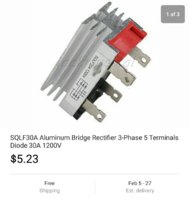rahndo
XS650 Addict
That didn't clean them.
Here's the charging system schematic for the 70-79 models:
View attachment 60746
Here's the charging system description for the 70-79 models:
View attachment 60747
Here's a blowup of the rectifier. We'll use this to describe the rectifier tests.
View attachment 60748
Set your meter to test resistance, on the 2K (2000 ohm) scale. On many meters, this position is also the diode test. If your meter uses unpluggable testleads, be sure the red testlead is in the (+) socket, black testlead in the (-) socket.
The rectifier must be unplugged from the harness for these tests.
First, the forward conduction tests:
For the ground-side diodes:
Clip the red testlead to the rectifier's negative (black wire) connector.
Using the black testlead, test each white wire connector (3 individual tests).
Meter should show some conductivity. If diode test feature exists, should show about 0.600-0.700.
For the hot-side diodes:
Clip the black testlead to the rectifier's positive (red wire) connector.
Using the red testlead, test each white wire connector (3 individual tests).
Meter should show some conductivity. If diode test feature exists, should show about 0.600-0.700.
Next, the reverse-bias (no conduction) tests:
For the ground-side diodes:
Clip the black testlead to the rectifier's negative (black wire) connector.
Using the red testlead, test each white wire connector (3 individual tests).
Meter should show no (zero) conductivity.
For the hot-side diodes:
Clip the red testlead to the rectifier's positive (red wire) connector.
Using the black testlead, test each white wire connector (3 individual tests).
Meter should show no (zero) conductivity.
That's the complete 12 test procedure. If any value is incorrect, the rectifier is bad.

Quick update, still waiting on some parts. Bike is now misfiring badly when I ride it. I pulled the carbs and cleaned the jets with compressed air and it's still misfiring.
I'm assuming that the bike is now finally running like youd expect with a failing charging system. I read a quote from retired gentleman in another thread, "forget the carbs and fuel system until you sort out your charging". Seems like solid advice.
Okay, you'd still replace the regulator even though it tested okay?
Is that just because it's outdated technology and is making the rest of the charging system work harder than it needs to?
Just ordered a rectifier and VR115 regulator, out of pocket about 40 US dollars. Mike is asking 102 for his plus it'd be 25 to ship it to me.
Now I just need to make sure my complete novice wiring skills are up to par.
Without wanting to get too controversial, does that mean that most of the people that replaced their stock charging system with a PMA didn't really need to?
Was having this discussion with a local 81 XS owner the other day and he was adamant that these charging systems needed to be replaced with a PMA or similar.
 The PMA sellers encourage this by heaping lots of hyperbole on their websites, while they make large profits from naive buyers.
The PMA sellers encourage this by heaping lots of hyperbole on their websites, while they make large profits from naive buyers. 
Replaced alternator brushes. Took off LHS cover and cleaned up everything and cleaned up clutch mechanism.
When trying to clean battery strap to starter relay the plastic has snapped off the top and now I can't get a ground and it's blowing fuses. Do I replace the starter relay or can I ground it somewhere else?
Still waiting on my rectifier and regulator. Ah the joys of living at the bottom of the earth
